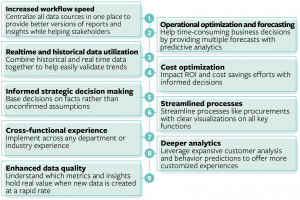Over the last few years, companies have increasingly relied on business intelligence (BI)—the tools and activities used to analyze business data and turn it into actionable insights—as a way to make better-informed and more valuable decisions. Gathering as much data as possible through analytical reporting is critical to this process.
An analytical report is a type of business report that analyzes qualitative and quantitative company and industry data to evaluate a business strategy or process, empowering management to make data-driven decisions based on evidence and analytics. Historically, it has been difficult to gain the kind of intelligence needed to do this effectively, but capabilities have greatly improved with the recent development of specific tools and processes.
The benefits of business intelligence and analytical reports
Adopting data-driven business practices can come with tremendous advantages if organizations approach their reporting correctly and strategically. The main goal of BI and analytical reports is to deliver comprehensive data that can be easily accessed and interpreted, providing actionable insights.
Some crucial benefits are:

Let’s explore how BI and analytics have evolved to better serve the business.
From early days to evolved business analytics
Analytics 1.0 came into existence at the beginning of “data analytics” during a period with fewer technological advancements than today. Companies aiming to analyze data and produce useful information from it had to collect the data offline and analyze it manually—and they spent much more time on collection than analysis. They also had access to a narrower range of data.
At that time, data analysts acted more as technicians who managed the technology and collected data. Since the work was manual, slow, and from limited data sources, mostly within the organization, companies had less insight to aid the decision-making process. In smaller companies, decision makers relied more on things like gut instinct, personal anecdotes, bias, and assumptions to inform their next move.
Transforming data into usable insights is a challenge because IT people see data one way while business analysts see it another. Part of the challenge of Analytics 1.0 was to clarify communication between the two groups so that the business could get what it needed from the data that IT generated. When it worked right, transformed data helped support evidence-based decision making and performance management and yielded insights. As the tools got better (and IT people began to better understand their stakeholders), even smaller organizations began to benefit from analytics.
“Data will talk if you’re willing to listen to it.”—Jim Bergeson
From business analytics to futuristic analytics
When the internet took hold in the early 2000s, the availability of data evolved from local to global, coining the phrase, “big data.” Analytics 2.0 was the phase during which almost every business that had a digital infrastructure started using tools like online analytical processing (OLAP), data mining, and others to deal with big data and achieve meaningful insights. But all this data created problems such as greater storage requirements and longer processing times.
Analytics 3.0 emerged as organizations began to make use of better search algorithms and data collection methods to overcome the volume challenges of OLAP platforms. Eventually, organizations also had to deal with unstructured data, which led to the use of NoSQL types of databases. New, faster technologies such as machine learning (ML) were later introduced to handle the advanced analytics.
“Data science” is the umbrella term for the constantly evolving technologies of the current era of automation and intelligent systems that we call Analytics 4.0. Advances in artificial intelligence (AI), ML, and deep learning—along with existing data-mining techniques and descriptive-predictive-prescriptive analytics and new machine-learning algorithms—have already spawned neural machine translation (NMT), smart reply, chatbots, and meeting assistants, etc., which will be used extensively for the next couple of years.
Next up, we’ll see a rise in “automated analytics,” where data originates from a variety of sources and even more analytical methods become available to interpret the data, leading companies to find new ways to leverage better-thinking machines.
Conclusion
BI, data, and analytics have evolved over the years from manual processes to more sophisticated approaches that leverage platforms, algorithms, and advanced BI tools. With the right data and analytical reports and methods, an organization can improve its vision and efficiency across the business.
Today at BMC, we are delivering a deep digital experience to our customers with the introduction of AI-driven service management (AISM) and AI-driven IT operations (AIOps) capabilities for the BMC Helix portfolio, which make it easier than ever to implement advanced analytics for service desk and change management processes. This portfolio helps you achieve a competitive advantage; make better, data-driven decisions; develop more effective marketing and new revenue opportunities; personalize customer experiences; and improve operational efficiency by identifying opportunities to optimize the service desk. To learn more, visit bmc.com/helix.
These postings are my own and do not necessarily represent BMC's position, strategies, or opinion.
See an error or have a suggestion? Please let us know by emailing blogs@bmc.com.






